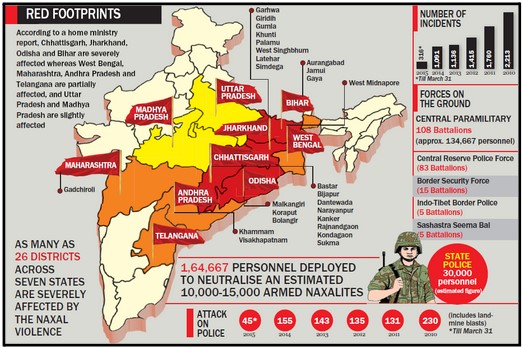GS-Internal Security
Naxalism, also known as left-wing extremism, is a significant armed rebellion against the State driven by leftist ideology.
It encompasses a variety of militant insurgent groups operating in India since the mid-1960s, with the goal of overthrowing the established government system. Naxalism remains one of the most pressing security challenges faced by India, requiring a multifaceted approach combining security measures, socio-economic development initiatives, and efforts to address the underlying grievances of affected communities.
About
- Naxalism, also referred to as left-wing extremism or Maoism, denotes violent acts perpetrated by tribal people and landless laborers against landlords, individuals, and groups.
- Naxalites or Maoists are the left-wing extremists who form the core of these militant groups in India.
Origin and History
- Naxalism emerged in 1967 in the regions of Khoribari, Phansidewa, and Naxalbari in West Bengal's Darjeeling District.
- Led by figures like Charu Majumdar, Kanu Sanyal, and Jangal Santhal, the movement initially aimed at securing land rights for working peasants.
- The Communist Party of India (Marxist-Leninist) was formed in 1969, laying the foundation for various Naxalite groups across India.
Geographical Spread
- Naxalism has spread beyond its West Bengal origins to encompass rural areas in states like Telangana, Andhra Pradesh, Odisha, Chhattisgarh, Jharkhand, Madhya Pradesh, Maharashtra, and Telangana.
- These regions constitute what is often termed the "Red Corridor," reflecting the dominance of Naxalite activities in these areas.

Objectives and Ideology
- Naxalite groups share an anti-government ideology and seek to achieve their goals through violent means.
- They aim to garner support from marginalised rural populations by advocating for their rights and exploiting their grievances against the government.
- The Communist Party of India (Maoist), or CPI-M, is the most prominent and violent among these groups, drawing ideological inspiration from Mao Zedong's principles.
- Naxalites reject the parliamentary system and advocate for armed revolt to overthrow the government.
Modus Operandi of naxalites.
- Naxalites employ severe violence, including attacks on security forces, government establishments, and civilians, to further their agenda.
- They operate in remote and densely forested areas, making it challenging for security forces to combat their activities effectively.
- Naxalites often run parallel administrations, imposing their own rules and regulations in the areas under their control.
|
Origins
Geographical Focus
Strategic Focus
Organizational Structure
Historical Context
NOTE:- Maoism and Naxalism share ideological roots in Mao Zedong's teachings and principles, Naxalism is a specific manifestation of Maoist ideology in the Indian context, characterised by armed insurgency and leftist extremism. |
Factors contributing to naxalism in India?
- Mismanagement of Forests: Historical mismanagement of forest resources, dating back to colonial rule, led to monopolization and exploitation. This disenfranchised forest-dwelling communities, fostering discontent and support for Naxalism.
- Ineffective Tribal Policies: Post-independence policies failed to address tribal alienation, exacerbating issues in regions like Orissa. Lack of resolution on crucial matters such as food security further fueled Naxalism.
- Growing Economic Disparities: Widening economic gaps attracted marginalized individuals to Naxalism. Government inaction on regional disparities contributed to the perception that Naxalism could provide solutions.
- Industrialization and Land Reform Failures: Poorly implemented land reforms and industrial policies worsened rural economic conditions. This discontent with government policies fueled Naxalism among rural populations.
- Geographical Challenges: Forested terrain provided favorable conditions for Naxal activities and guerrilla warfare tactics. The challenging geography of Naxal-affected areas complicates security operations.
- Youth Recruitment: Educated youth, including graduates, are drawn to Naxal ideologies. Universities serve as hubs for radicalization, attracting youth to extremist beliefs.
- Tribal Discontent: Legislation restricting tribal access to forest resources heightened resentment. Massive displacement due to development projects further fueled support for Naxalism.
Government Initiatives to Combat Naxalism
- Police Force Modernization: The government initiated a Police Modernization Scheme aimed at equipping state police forces with contemporary gear and infrastructure, bolstering their operational capacity.
- Multi-Agency Coordination: Central and State Multi-Agency Centres (MAC and SMAC) have proven instrumental in coordinating intelligence and operational efforts, particularly in high-risk zones such as Jagdalpur and Gaya.
- Deployment of Central Paramilitary Forces: The deployment of Central Reserved Police Forces (CRPF), totaling over 70,000 personnel, along with the establishment of Specialized Commando Battalion (CoBRA) units, signifies a strategic emphasis on enhancing counterinsurgency capabilities.
- SAMADHAN Initiative: Launched under the auspices of the NDA government, SAMADHAN underscores a multifaceted approach incorporating Smart Leadership, Aggressive Strategy, Motivation and Training, Actionable Intelligence, Technological Advancements, and Financial Disruption.
- Backward Districts Initiative and BRGF: Commencing in 2003-2004, these initiatives earmarked substantial funds to address developmental deficits in 55 severely affected areas across 9 states, fostering sustainable growth and social stability.
- Integrated Action Plan (IAP): Introduced in 2010, the IAP endeavors to address the entrenched grievances of marginalized communities, enacting legislation to uphold their rights and enhance socio-economic inclusivity.
- USOF and PMGSY: The Universal Services Obligation Fund (USOF) facilitates the expansion of mobile networks in Naxal-affected regions, while the Pradhan Mantri Gram Sadak Yojana (PMGSY) promotes rural connectivity, bolstering economic resilience.
- MGNREGA and Social Welfare Schemes: Programs such as the Mahatma Gandhi National Rural Employment Guarantee Act (MGNREGA) are pivotal in providing livelihood opportunities in affected districts, alongside targeted health and education initiatives to uplift vulnerable communities.
- Legislative Support: Enactment of progressive legislation such as the Rehabilitation and Resettlement Policy, 2007, and the Forest Rights Act, 2006, serves to empower marginalized groups and foster inclusive development.
Laws and Initiatives to Combat Naxalism
- National Rehabilitation and Resettlement Policy, 2007: Address displacement caused by land acquisition for industrial purposes.
- Forest Rights Act, 2006: Recognize rights of forest dwellers and scheduled communities in forest areas.
- Chhattisgarh Special Public Securities Act, 2006: Define unlawful activities and empower the government to take preventive measures.
- Chhattisgarh Special Public Securities Bill of 2005: Grants District Magistrates authority to designate areas for unlawful activities.
Recommendations to Address Naxalism
- Long-term and Short-term Program of Action: Formulate a comprehensive Program of Action spanning 10 years, complemented by a shorter-term 5-year plan based on the '14-Point Strategy' articulated in Parliament. This collaborative effort between the Union and State Governments will tailor strategies to address state-specific challenges.
- Capacity Building of Security Forces: Enhance the capabilities of security forces to effectively and decisively counter Naxalism while adhering to constitutional principles and respecting human rights. This includes specialized training and equipping forces with the necessary resources.
- Sensitization and Reorientation: Conduct training programs aimed at sensitizing police and paramilitary personnel to the underlying causes of Naxalite movements. By understanding the socio-economic grievances driving extremism, security forces can adopt more nuanced and empathetic approaches.
- Formation of Special Task Forces: Establish specialized task forces modeled after successful units like the Greyhounds in Andhra Pradesh. These units should be highly trained and equipped to conduct targeted operations against Naxalite insurgents.
- Strengthening Local Police Presence: Strengthen local law enforcement by establishing and reinforcing police stations in Naxal-affected regions. These stations should be staffed by locally recruited personnel who possess a deep understanding of the local context and dynamics.
- Multi-disciplinary Oversight Committees: Establish multi-disciplinary oversight committees tasked with ensuring the effective implementation of the Forest Rights Act. By addressing issues related to land rights and resource management, these committees can mitigate socio-economic grievances that fuel Naxalism.
- Disrupting Financial Support Networks: Target the illicit nexus between illegal mining/forest contractors, transporters, and Naxalite groups that provides financial sustenance to the extremist movement. Disrupting these networks is essential to undermine the financial backbone of Naxalism and weaken its operational capabilities.
Way Forward
- Innovative Solutions: Creative strategies are needed to locate and counter armed groups operating in forested regions. Utilization of advanced technology and intelligence-gathering methods can enhance effectiveness.
- Utilization of Local Police: Local police possess valuable expertise in language and terrain, making them essential for successful operations. Training and equipping local law enforcement agencies can improve their ability to combat Naxalism effectively.
- Specialized Task Forces: Establishment of specialized units, modeled after successful initiatives like Andhra Pradesh's 'Greyhounds', can enhance counterinsurgency efforts. These units should be equipped and trained to navigate challenging terrains and engage in guerrilla warfare tactics.
- Balanced Approach: Prioritize the safety and security of civilians while simultaneously focusing on the socio-economic development of Naxal-affected regions. Investing in infrastructure, education, healthcare, and livelihood opportunities can address underlying grievances and weaken support for Naxalism.
- Collaborative Efforts: Recognize Naxalism as a shared responsibility between the central and state governments, necessitating collaborative efforts. Coordination between intelligence agencies, law enforcement, and local administrations is crucial for effective counterinsurgency operations.

